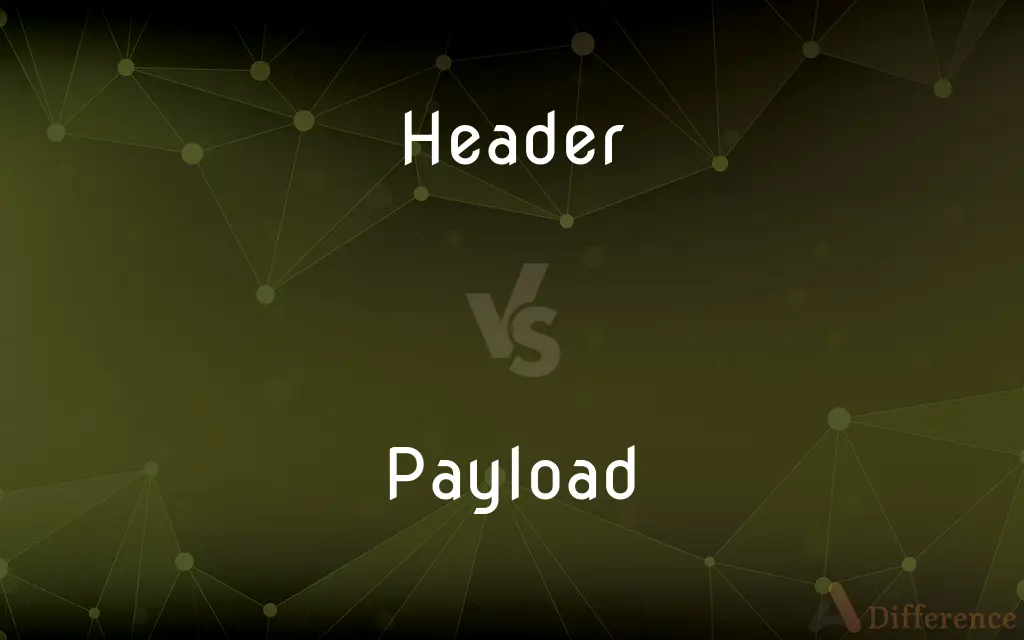Header vs. Payload — What's the Difference?
By Tayyaba Rehman & Urooj Arif — Updated on April 2, 2024
Header contains control information for data processing, while payload is the actual data transmitted in a communication.

Difference Between Header and Payload
Table of Contents
ADVERTISEMENT
Key Differences
In data transmission and communication protocols, a header is the part of the data packet that contains control information. This information is used by networking hardware and software to deliver the packet to its intended destination and to ensure the data is processed correctly. Headers include details such as source and destination addresses, error-checking codes, and protocol type. On the other hand, the payload is the actual data that is being transmitted. It is the content that the user or application intends to send, such as text, images, or other types of information. While the header facilitates the delivery and integrity of the payload, the payload itself is the primary reason for the communication.
Headers are critical for the efficient and accurate delivery of data across networks. They determine the path that the data packet takes from sender to receiver, and they ensure that the data adheres to specific communication protocols. Payloads, whereas, are indifferent to the mechanisms of data transmission. Their integrity and relevance are preserved regardless of the route taken or the protocols employed, as long as the headers are interpreted correctly.
While the size of the header is relatively small compared to the payload in most communication systems, its importance cannot be understated. The header contains essential information that, if missing or incorrect, could lead to data loss or misdelivery. In contrast, the payload can be of varying size, from a few bytes in a simple text message to large amounts of data in video or file transfers.
The content of a header is largely determined by the requirements of the network protocol and the type of data being transmitted. For example, a packet in the Internet Protocol (IP) will have an IP header with specific fields like version, header length, and time to live (TTL). Meanwhile, the payload is determined by the application generating the data, and it is encapsulated within the packet, untouched by the network layers that process the packet's header.
Headers and payloads play distinct yet complementary roles in data communication. The header is concerned with the delivery, integrity, and proper handling of the data packet within the network, ensuring that the payload reaches its intended destination accurately and efficiently. The payload, however, is the essence of the communication, carrying the actual information that needs to be transmitted.
ADVERTISEMENT
Comparison Chart
Definition
Part of the data packet containing control information.
The actual data transmitted.
Purpose
Facilitates delivery and integrity of the data packet.
Contains the content intended for communication.
Content
Source and destination addresses, protocol type, error-checking codes.
User or application data, such as text, images, or video.
Size
Relatively small compared to the payload.
Can vary significantly, often much larger than the header.
Determined by
Network protocol requirements.
Application generating the data.
Compare with Definitions
Header
Used in protocols to ensure correct data processing.
The TCP header includes a sequence number for data reassembly.
Payload
Can be encrypted for secure communication.
The payload is encrypted to protect sensitive information during transmission.
Header
The section of a data packet that contains control and routing information.
The header specifies the data format and destination.
Payload
Varies in size depending on the message content.
Video streaming services send payloads containing large video files.
Header
Determines the protocol and version used.
The IP header indicates whether the packet uses IPv4 or IPv6.
Payload
Contains the data sent by the user or application.
The payload in a file transfer includes the file's contents.
Header
Contains information about the data's source and destination.
Email headers reveal the sender and recipient's addresses.
Payload
The part of transmitted data that is the actual intended message.
The payload of the email is the body text and attachments.
Header
Includes error-checking data to verify integrity.
The header's checksum helps detect data corruption during transmission.
Payload
Is processed by the receiving application.
A web server processes the payload of a request to return the requested page.
Header
A shot or pass made with the head.
Payload
Payload is the object or the entity which is being carried by an aircraft or launch vehicle. Sometimes payload also refers to the carrying capacity of an aircraft or launch vehicle, usually measured in terms of weight.
Header
A headlong fall or dive.
Payload
The revenue-producing part of a cargo.
Header
A brick or stone laid at right angles to the face of a wall.
Payload
The total weight of passengers and cargo that an aircraft carries or can carry.
Header
A line or block of text appearing at the top of each page of a book or document.
Payload
The total weight of the instruments, crew, and life-support systems that a spacecraft carries or can carry.
Header
A raised tank of water maintaining pressure in a plumbing system.
Payload
The passengers, crew, instruments, or equipment carried by an aircraft, spacecraft, or rocket.
Header
A person who ropes a steer by its head (as opposed to its heels), especially in a team-roping rodeo event
The steer ran straight and the header made a good catch
Payload
An explosive charge, biological or chemical agent, or other destructive element borne by a missile or bomb.
Header
A mad or foolish person.
Payload
That part of a cargo that produces revenue.
Header
One that fits a head on an object.
Payload
The total weight of passengers, crew, equipment, and cargo carried by an aircraft or spacecraft.
Header
One that removes a head from an object, especially a machine that reaps the heads of grain and passes them into a wagon or receptacle.
Payload
That part of a rocket, missile, propelled stinger, or torpedo that is not concerned with propulsion or guidance, such as a warhead or satellite.
Header
A pipe that serves as a central connection for two or more smaller pipes.
Payload
(computing) The functional part of a computer virus or another type of malware program, rather than the part that spreads it.
Header
A floor or roof beam placed between two long beams that supports the ends of the tailpieces.
Payload
(communication) The actual data in a data stream.
Header
A brick or stone laid at a right angle to the face of a wall so that only its short end is showing. Also called bonder.
Payload
The part of a missile or torpedo that carries the explosive charge.
Header
(Informal) A headlong dive or fall.
Payload
The goods carried by a large vehicle.
Header
(Sports) A pass or shot made in soccer by heading the ball.
Payload
The front part of a guided missile or rocket or torpedo that carries the nuclear or explosive charge or the chemical or biological agents
Header
Textual information, such as a title, date, or page number, positioned in the top margin of a page and usually repeated throughout a document.
Payload
Goods carried by a large vehicle
Header
A raised tank or hopper that maintains a constant pressure or supply to a system, especially the small tank that supplies water to a central heating system.
Header
The upper portion of a page (or other) layout.
If you reduce the header of this document, the body will fit onto a single page.
Header
Text, or other visual information, used to mark off a quantity of text, often titling or summarizing it.
Your header is too long; "Local Cannibals" will suffice.
Header
Text, or other visual information, that goes at the top of a column of information in a table.
That column should have the header "payment status".
Header
(informal) A font, text style, or typesetting used for any of the above.
Parts of speech belong in a level-three header. Level-two headers are reserved for the name of the language.
Header
(computing) The first part of a file or record that describes its contents.
The header includes an index, an identifier, and a pointer to the next entry.
Header
(programming) header file
Header
(networking) the first part of a packet or stream, often containing its address and descriptors.
The encapsulation layer adds an eight-byte header and a two-byte trailer to each packet.
Header
(masonry) A brick that is laid sideways at the top of a wall or within the brickwork with the short side showing.
This wall has four header courses.
Header
A horizontal structural or finish piece over an opening.
Header
A machine that separates and gathers the heads of grain etc.
They fed the bale into the header.
Header
(soccer) The act of hitting the ball with the head.
His header for the goal followed a perfect corner kick.
Header
(soccer) Someone who heads the ball.
Diving header
Header
A headlong fall, jump or dive.
The clown tripped over the other clown and took a header.
Header
A raised tank that supplies water at constant pressure, especially to a central heating and hot water system.
Header
A pipe which connects several smaller pipes.
Common practice is to use plastic pipes with iron headers.
Header
The rodeo performer who drives the steer toward the heeler to be tied.
Header
One who puts a head on something.
Header
To strike (a ball) with one's head.
Header
One who, or that which, heads nails, rivets, etc., esp. a machine for heading.
Header
One who heads a movement, a party, or a mob; head; chief; leader.
Header
A brick or stone laid with its shorter face or head in the surface of the wall.
Header
A reaper for wheat, that cuts off the heads only.
Header
A fall or plunge head first, as while riding a bicycle, or a skateboard, or in bathing; - sometimes, implying the striking of the head on the ground; as, to take a header.
Header
A line of text serving to indicate what the passage below it is about;
The heading seemed to have little to do with the text
Header
Horizontal beam used as a finishing piece over a door or window
Header
Brick that is laid sideways at the top of a wall
Header
A framing member crossing and supporting the ends of joists, studs, or rafters so as to transfer their weight to parallel joists, studs, or rafters
Header
A machine that cuts the heads off grain and moves them into a wagon
Header
(soccer) the act of hitting the ball with your head
Header
A headlong jump (or fall);
He took a header into the shrubbery
Common Curiosities
Why are headers important in data communication?
Headers ensure the data packet's delivery, integrity, and adherence to communication protocols.
What type of information does a header contain?
A header includes source and destination addresses, error-checking codes, and protocol type.
What is the main difference between a header and a payload?
The header contains control information for data processing, while the payload is the actual data transmitted.
How does the payload relate to the application generating the data?
The payload is determined by the application generating the data and contains the content intended for communication.
Is the content of the header always the same?
No, the content of the header is determined by network protocol requirements and can vary depending on the type of data transmitted.
Can payload data be encrypted?
Yes, payload data can be encrypted to protect sensitive information during transmission.
Are headers larger than payloads?
Typically, headers are smaller than payloads, as they contain only control information.
What happens if header information is incorrect or missing?
Incorrect or missing header information can lead to data loss, misdelivery, or incorrect processing of the data packet.
Can the payload be of any size?
Yes, the payload can vary significantly in size, often being much larger than the header.
How do headers and payloads complement each other?
Headers facilitate the efficient and accurate delivery of payloads, which contain the actual data intended for communication.
Share Your Discovery

Previous Comparison
Violence vs. Peace
Next Comparison
Adversely vs. ConverselyAuthor Spotlight
Written by
Tayyaba RehmanTayyaba Rehman is a distinguished writer, currently serving as a primary contributor to askdifference.com. As a researcher in semantics and etymology, Tayyaba's passion for the complexity of languages and their distinctions has found a perfect home on the platform. Tayyaba delves into the intricacies of language, distinguishing between commonly confused words and phrases, thereby providing clarity for readers worldwide.
Co-written by
Urooj ArifUrooj is a skilled content writer at Ask Difference, known for her exceptional ability to simplify complex topics into engaging and informative content. With a passion for research and a flair for clear, concise writing, she consistently delivers articles that resonate with our diverse audience.














































